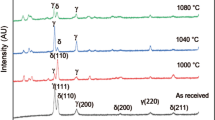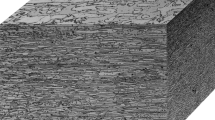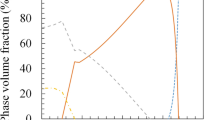Abstract
The improvement of mechanical strength and corrosion in duplex stainless steels can be maximized when the fractions between phases (α) and (γ) are balanced. Machining operations may compromise surface integrity through microstructural deformations. In this study, surface milling of a 2205 duplex steel was performed under Vc conditions between 298 and 651 m/min and fz between 0.04 and 0.18 mm/tooth. The microstructural evolution characteristics, mechanical properties and residual stresses were investigated by optical microscopy, SEM, MFM, XRD and Vickers microhardness. After milling, microstructure was found to be deformed by shearing of the cutting tool, and the volume fraction of austenite and ferrite was altered, as determined by Rietveld refinements because of the transformation of austenite into martensite (α') induced by plastic deformation. The samples also exhibited variations in phase-specific microhardness, associated with strain-induced martensite formation and the presence of tensile residual stresses.










Similar content being viewed by others
Availability of data and materials
The authors declare that all data supporting the findings of this study are available within the article.
Code availability
Not applicable.
References
Baddoo NR (2008) Stainless steel in construction: a review of research, applications, challenges and opportunities. J Constr Steel Res 64:1199–1206. https://doi.org/10.1016/j.jcsr.2008.07.011
Vinoth Jebaraj A, Ajaykumar L, Deepak CR, Aditya KVV (2017) Weldability, machinability and surfacing of commercial duplex stainless steel AISI2205 for marine applications – a recent review. J Adv Res 8:183–199. https://doi.org/10.1016/j.jare.2017.01.002
Lopes Mougo A, de Oliveira Campos F, Araujo AC (2018) Mechanistic study on micromilling of the super duplex stainless steel UNS S32750. J Manuf Process 34:31–39. https://doi.org/10.1016/j.jmapro.2018.05.017
Nomani J, Pramanik A, Hilditch T, Littlefair G (2016) Investigation on the behavior of austenite and ferrite phases at stagnation region in the turning of duplex stainless steel alloys. Metall Mater Trans A Phys Metall Mater Sci 47A:3165–3177. https://doi.org/10.1007/s11661-016-3472-0
Philip Sevaraj D, Chandramohan P, Chandrasekar P (2018) Experimental investigations of nitrogen alloyed duplex stainless steel in dry milling process. J Eng Sci Technol 13:321–331
Maurotto A, Tsivoulas D, Gu Y, Burke MG (2017) Effects of machining abuse on the surface properties of AISI 316L stainless steel. Int J Press Vessel Pip 151:34–44. https://doi.org/10.1016/j.ijpvp.2017.02.004
Talonen J, Hänninen H (2007) Formation of shear bands and strain-induced martensite during plastic deformation of metastable austenitic stainless steels. Acta Mater 55:6108–6188. https://doi.org/10.1016/j.actamat.2007.07.015
Nomani J, Pramanik A, Hilditch T, Littlefair G (2015) Chip formation mechanism and machinability of wrought duplex stainless steel alloys. Int J Adv Manuf Technol 80:1127–1135. https://doi.org/10.1007/s00170-015-7113-3
Policena MR, Devitte C, Fronza G, Garcia RF, Souza AJ (2018) Surface roughness analysis in finishing end-milling of duplex stainless steel UNS S32205. Int J Adv Manuf Technol 98:1617–1625. https://doi.org/10.1007/s00170-018-2356-4
Kundrak J, Mamalis AG, Gyani K, Bana V (2011) Surface layer microhardness changes with high-speed turning of hardened steels. Int J Adv Manuf Technol 53:105–112. https://doi.org/10.1007/s00170-010-2840-y
Moser NH, Gross TS, Korkolis YP (2014) Martensite formation in conventional and isothermal tension of 304 austenitic stainless steel measured by X-ray diffraction. Metall Mater Trans A Phys Metall Mater Sci 45:4891–4896. https://doi.org/10.1007/s11661-014-2422-y
Rajaguru J, Arunachalam N (2020) A comprehensive investigation on the effect of flood and MQL coolant on the machinability and stress corrosion cracking of super duplex stainless steel. J Mater Process Technol 276:116417. https://doi.org/10.1016/j.jmatprotec.2019.116417
Queiroga LR, Fernanda G, Santos M et al (2019) ScienceDirect Influence of machining parameters on surface roughness and susceptibility to hydrogen embrittlement of austenitic stainless steels. Int J Hydrog Energy 44:29027–29033. https://doi.org/10.1016/j.ijhydene.2019.09.139
Lyon KN, Marrow TJ, Lyon SB (2015) Influence of milling on the development of stress corrosion cracks in austenitic stainless steel. J Mater Process Technol 218:32–37. https://doi.org/10.1016/j.jmatprotec.2014.11.038
Zhang W, Fang K, Hu Y, Wang S, Wang X (2016) Effect of machining-induced surface residual stress on initiation of stress corrosion cracking in 316 austenitic stainless steel. Corros Sci 108:173–184. https://doi.org/10.1016/j.corsci.2016.03.008
Rajaguru J, Arunachalam N (2018) Investigation on machining induced surface and subsurface modifications on the stress corrosion crack growth behaviour of super duplex stainless steel. Corros Sci 141:230–242. https://doi.org/10.1016/j.corsci.2018.07.012
Kaynak Y, Kitay O (2018) Porosity, surface quality, microhardness and microstructure of selective laser melted 316L stainless steel resulting from finish machining. J Manuf Mater Process 2:36. https://doi.org/10.3390/jmmp2020036
Krolczyk G, Nieslony P, Legutko S (2014) Microhardness and surface integrity in turning process of duplex stainless steel (DSS) for different cutting conditions. J Mater Eng Perform 23:859–866. https://doi.org/10.1007/s11665-013-0832-4
Li W, Guo Y, Guo C (2013) Superior surface integrity by sustainable dry hard milling and impact on fatigue. CIRP Ann Manuf Technol 62:567–570. https://doi.org/10.1016/j.cirp.2013.03.024
González H, Calleja A, Pereira O, Ortega N, López de Lacalle L, Barton M (2018) Super abrasive machining of integral rotary components using grinding flank tools. Metals (Basel) 8:24. https://doi.org/10.3390/met8010024
Lutterotti L (2010) Total pattern fitting for the combined size-strain-stress-texture determination in thin film diffraction. Nucl Instrum Methods Phys Res Sect B Beam Interact with Mater Atoms 268:334–340. https://doi.org/10.1016/j.nimb.2009.09.053
ASTM International (2012) ASTM E2860-12, standard test method for residual stress measurement by x-ray diffraction for bearing steels. E2860-12. https://doi.org/10.1520/E2860
Forgas Júnior A, Otubo J, Magnabosco R (2016) Ferrite quantification methodologies for duplex stainless steel. J Aerosp Technol Manag 8:357–362. https://doi.org/10.5028/jatm.v8i3.653
Nilsson JO (1992) Super duplex stainless steels. Mater Sci Technol (UK) 8:685–700. https://doi.org/10.1179/mst.1992.8.8.685
Tsay LW, Young MC, Shin CS, Chan SLI (2007) Hydrogen-enhanced cracking of 2205 duplex stainless steel. Fatigue Fract Eng Mater Struct 30:1228–1236. https://doi.org/10.1111/j.1460-2695.2007.01191.x
Barbosa PA, Machado IF (2011) Strain rate effect on the mechanical behavior of austenitic stainless steel during machining. Adv Mater Res 223:332–339. https://doi.org/10.4028/www.scientific.net/AMR.223.332
Krolczyk G, Legutko S, Nieslony P, Gajek M (2014) Study of the surface integrity microhardness of austenitic stainless steel after turning. Teh Vjesn 21:1307–1311
Guo LQ, Lin MC, Qiao LJ, Volinsky AA (2013) Ferrite and austenite phase identification in duplex stainless steel using SPM techniques. Appl Surf Sci 287:499–501. https://doi.org/10.1016/j.apsusc.2013.09.041
Femenia M, Canalias C, Pan J, Leygraf C (2003) Scanning Kelvin probe force microscopy and magnetic force microscopy for characterization of duplex stainless steels. J Electrochem Soc 150:274–281. https://doi.org/10.1149/1.1572482
Seo CH, Kwon KH, Choi K, Kim KH, Kwak JH, Lee S, Kim NJ (2012) Deformation behavior of ferrite-austenite duplex lightweight Fe-Mn-Al-C steel. Scr Mater 66:519–522. https://doi.org/10.1016/j.scriptamat.2011.12.026
Sahu P, De M, Kajiwara S (2002) Microstructural characterization of Fe-Mn-C martensites athermally transformed at low temperature by Rietveld method. Mater Sci Eng A 333:10–23. https://doi.org/10.1016/S0921-5093(01)01814-7
Kolednik O, Albrecht M, Berchthaler M, Germ H, Pippan R, Riemelmoser F, Stampfl J, Wei J (1996) The fracture resistance of a ferritic-austenitic duplex steel. Acta Mater 44:3307–3319. https://doi.org/10.1016/1359-6454(95)00412-2
Yan DP, Hilditch T, Kishawy HA, Littlefair G (2013) On quantifying the strain rate during chip formation when machining aerospace alloy Ti-5553. Procedia CIRP 8:123–128. https://doi.org/10.1016/j.procir.2013.06.076
Acknowledgements
This study was financed in part by the Coordenação de Aperfeiçoamento de Pessoal de Nível Superior - Brasil (CAPES) - Finance Code 001. The authors acknowledge the Microscopy Center of the UFMG for assistance in electron microscopy analyses and Centro Nacional de Pesquisa em Energia e Materiais (CNPEM) for the work on MFM and residual stress.
Funding
This study was financed in part by the Coordenação de Aperfeiçoamento de Pessoal de Nível Superior - Brasil (CAPES) - Finance Code 001
Author information
Authors and Affiliations
Contributions
Carlos Eduardo dos Santos: conceptualization, experiments, writing; José Rubens Gonçalves Carneiro: conceptualization and project supervision; Gilmar Cordeiro da Silva: project supervision; Pedro Paiva Brito: data analysis, writing; Thais Roberta Campos: experiments; Ítalo Bruno dos Santos: experiments
Corresponding authors
Ethics declarations
Ethics approval
Not applicable.
Consent to participate
Not applicable.
Consent for publication
Not applicable.
Conflict of interest
The authors have no conflicts of interest to declare that are relevant to the content of this article.
Additional information
Publisher’s note
Springer Nature remains neutral with regard to jurisdictional claims in published maps and institutional affiliations.
Rights and permissions
About this article
Cite this article
dos Santos, C.E., Carneiro, J.R.G., da Silva, G.C. et al. Residual stress and surface microhardness post-milling in 2205 duplex steel. Int J Adv Manuf Technol 113, 3445–3455 (2021). https://doi.org/10.1007/s00170-021-06829-6
Received:
Accepted:
Published:
Issue Date:
DOI: https://doi.org/10.1007/s00170-021-06829-6




